5 Disturbing Implications of Famous Children's Movies
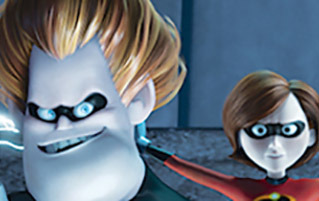
It seems like kids' movies are in a golden age ... by which we mean they're making studios literal piles of gold. Because of this, studios know to keep their family flicks lighthearted. Modern kids' movies are the one category you can count on being free of the dystopian landscapes and seamy underbellies found in films geared towards older crowds, and the only price you pay is having to put up with a talking radish or a rapping pigeon.
That is, unless you stop and think about them for more than five minutes. That's when the horror starts to reveal itself ...
Who Framed Roger Rabbit? -- Humans Made Themselves Obsolete

In Who Framed Roger Rabbit?, we discover that the cartoon characters we love, envy, and have weird fetishes about during puberty are actually actors playing roles, just like their human counterparts. They have their own lives -- they just play wacky cartoon characters as their day job.
But the fact that the toons are real doesn't mean they play by real world rules; they can take a huge amount of punishment, and they don't get injured or sick, so they don't face the same everyday dangers that humans do. The fact that the movie's villain, Judge Doom, found a way to kill toons is considered absolutely shocking.

Our mathematicians estimate that two-thirds of you have spontaneously started crying.
But Wait:
There are a lot of frightening implications of humans and cartoons living side by side, but chief among them is the fact that the functionally immortal and indestructible toons are essentially gods. They don't age, they don't get hurt, and they have no reason to fear humanity -- especially after Doom, the only guy who knows how to make the chemical that kills toons, is destroyed by his own creation.
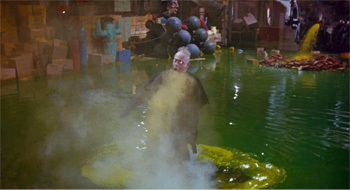
Our mathematicians estimate that every single one of you is now hooting and applauding wildly.
Now sure, the toons seem harmless and fun. But how long will it be until they realize that they don't need humans around anymore? We don't care how tough you are -- years of being made the butt of jokes, dropped anvils, and misfiring Acme weapons would wear on you. Who Framed Roger Rabbit? is like a dark science fiction story that tries to warn humanity of its own follies, but with a cartoon character that every young boy from the era secretly jerked off to.
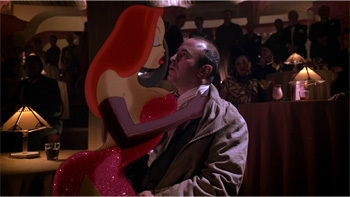
Her look-alike wasn't half-bad either.
Not to mention how, despite all the entertainment they provide, the toons are treated as second-class citizens. They all live in a walled-off corner of town, and they're relegated to menial service jobs once they're not popular anymore. Forget them realizing that they're more powerful -- they're the very definition of an oppressed population, which is always a powder keg.
Or hell, how long before a human decides to weaponize them? If an aspiring supervillain wanted a giant, flying, bulletproof armadillo that shoots lasers out of its eyes, it's just a drawing board away from becoming a reality and facilitating a bank robbery. It really changes the message of the movie when you realize that Doom did humanity a favor by figuring out a way to wipe out the toons. Had his villainous schemes skewed less towards "getting rich through murder and shady real estate deals" and more "conquering humanity," what would have stopped him? At least his acts made us aware of the possibility of a wacky, silly, and comedic violent uprising.
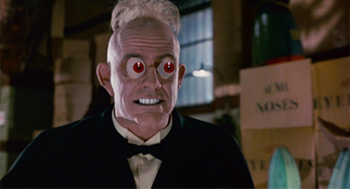
Never forget.
The Incredibles -- The Return of Heroes Means the Return of Villains

The world of Pixar's The Incredibles is full of superheroes with awe-inspiring powers and abilities far beyond those of normal humans, like super strength, super speed, and super keeping-your-marriage-interesting.

Otherwise known as elasticity.
They keep the world safe from crime, but thanks to collateral damage caused by their heroics, they become the targets of expensive lawsuits. This leads to the government banning superheroes, who are placed in a witness-protection-style program designed to hide their powers and identities and integrate them into the rest of society. It seems to work pretty well.
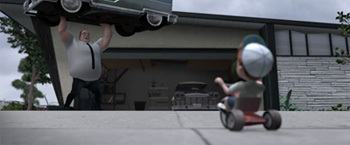
Seamless!
But Wait:
There's an early scene where Mr. Incredible and Samuel L. Jackson reminisce about the good old days, when they fought supervillains as tough as the heroes themselves.

The French one dressed as a mime, because of course he did.
The ban on heroism prevented heroes from heroing without the fear of legal action, but the supervillains were already operating outside the law -- the ban opened the door to a whole new world of crime. You'd half-expect the newly unstoppable villains to take over the planet, but flash-forward 15 years and there's no evidence of mass slavery, destroyed cities, a villain king -- nothing. The supervillains are apparently as extinct as the heroes. When Mr. Incredible sneaks out to do some occasional crime fighting by night, he's taking on regular old petty criminals.
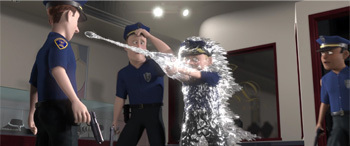
And resisting regular old arrest while abusing regular old cops. All in a hero's work.
Of course, the movie isn't 90 minutes of watching Mr. Incredible work his tedious office job -- he and his family eventually battle the villainous Syndrome. But he's the only bad guy in sight, and his motive of social change is very different than the motives of profiteering mimes. We're forced to assume that the villains were either dealt with after the ban, or got bored with having no one to challenge them and thus retired to wherever supervillains spend their golden years. Maybe they all got book deals, who knows.
However, almost immediately after the Incredibles defeat Syndrome and make it known that heroes are back, they're attacked by a new supervillain called the Underminer. The first supervillain to appear in years.
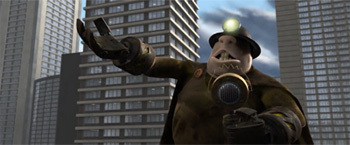
He looks like he could be defeated by a Boy Scout troop, but still.
It's almost as if once the heroes decided that they were making a public comeback, the dormant supervillains decided that they were coming back too, and that means the return of the horrifically damaging fights that got the heroes banned in the first place. The villains forced the heroes into hiding, which made the villains retire, until the heroes decided they were coming back, which made the villains come back, and so on. The cycle could last forever. This may mark the first time in theatrical history that a government ban was a smart move.
Cars 2 -- Rampant Repression and Mockery of the Disabled

Cars 2: Look, Pixar Just Needs to Pay A Few Bills, Okay? continues the story of Mater, voiced by Larry the Cable Guy, and Lightning McQueen, voiced by the Wilson brother who wasn't in Anchorman. This time around, they're plunged into international intrigue and danger while on a race around the world, providing ample room for lots of "Hey look, it's Larry the Cable Guy in another country! They're foreign and he's not used to that!"

Comedy!
The villains of the story are a group of lemons -- cars who were shoddily built and constantly need repair. Their goal is to discredit a new alternative fuel and get rich from their ownership of oil reserves, but they also want violent revenge against a society that's mocked them and treated them like second-class citizens. Their evil schemes are eventually foiled by Larry the Cable Car Guy, which suggests that their schemes were pretty shitty.
But Wait:
The lemons' plan was murderous, environmentally disastrous, and just generally all-around evil -- we aren't denying that. But they're extremists from an underclass that is clearly the real victim here. The lives of these shoddy cars, from start to finish, are dominated by their need to be repaired at a moment's notice. They're poorly constructed, they keep breaking, and they're notorious for faulty parts and bad workmanship.
Now replace spare parts with organs, and oil and gas with blood, and you get human characters who were born with serious medical conditions and would spend a lot of their lives in pain and suffering. Only in this universe, it's normal to treat them with scorn and constantly mock them.
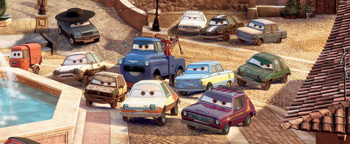
Making fun of their gas mileage is like mocking someone's wheelchair.
Humanity mostly grew out of shunning the terminally ill and physically disabled decades ago (mostly), yet it's still perfectly acceptable in the world of Cars. But wait, it gets worse. It's plainly stated that replacement parts are a thing, so either the resources for these cars to be properly repaired are available but just aren't used because of what they are, or the resources are rare, in which case terminally ill cars are constantly being insulted for having the audacity to be born.
The lemons have all the makings of a classic Disney underdog -- they're underdeveloped, underappreciated by their peers, and constantly mocked by the cool cars. Even common courtesy and discretion is abandoned if the car in question is weird enough -- the otherwise open-minded Mater flees in terror from a car that has its eyes in a different place than "normal" cars.

"I am empty inside. Nothing drives me. Look within yourself Mater, and you shall discover the same."
So who are the real villains -- the lemons, or the millions of other cars who drove them to evil by pointing and laughing at them for years while providing little to no treatment for their debilitating problems? Apparently, the film's message of "be who you are" is lost on the very cars we're supposed to call heroes.

Cloudy With a Chance of Meatballs 2 -- Mass Starvation or Genocide

The first Cloudy With a Chance of Meatballs is about Flint Lockwood, an inventor who lives on an island where sardines are the only food available. Disgusted with the lack of choice, he invents a machine that turns water into food.

If you haven't seen it, this screenshot serves as a detailed synopsis.
He eventually loses control of the machine, and the island is almost destroyed. In 2 Cloudy 2 With 2 Chance 2 Meatballs, the island is evacuated by Live Corp (think Apple, but evil ... so think Apple), who are attempting to make the island habitable again. Flint and his friends later return and discover that his invention is now producing living food. The "foodimals" evolved to create a balanced ecosystem, or at least as balanced as you can get when a mosquito made of toast sucks up a butter frog.

It's that damn circle of life Elton John tried to warn us about.
They eventually realize that the foodimals are benevolent beings who are more-or-less sentient and aware of what's happening to them, and our heroes defend their right to life from Live Corp, which wants to exploit them. The film ends with the island's 14,000 original inhabitants moving back home and living happily ever after.

They'll hit a million once the peanut butter and jelly animals find one another and get freaky.
But Wait:
There's now very little food on the island that isn't a thinking, feeling being. The movie spent its entire runtime explaining that foodimals have a right to live, and shouldn't be exploited for food. That's a great sentiment, except now 14,000 hungry, hungry humans have moved back into an area with both an extremely limited supply of food and competition that's made of food.

Not that you'd want to eat them.
So the newly returned humans must either dramatically increase their non-sentient food production (unlikely, given the overrun state of the island), or start harvesting the foodimals (the same creatures they just spent the entire movie defending). This isn't like not wanting to eat lamb after playing with one at the petting zoo -- at one point we see some pickles fishing with rods, making them more intelligent than any real animal. Hell, even if you could work up the nerve to eat these things, wouldn't they all be considered endangered? It's like trying to suddenly settle 14,000 people on the Galapagos, if every living creature there was smart enough to use tools and constantly looked at you with doe eyes.

Eat four to five servings of gut-wrenching guilt per day for better health.
Labyrinth -- David Bowie Implicitly Killed Countless Other Children

Labyrinth, aside from possibly being all about masturbation, is like a highlight reel for the 1980s. It features Muppets, a young Jennifer Connelly, and amazing performances by David Bowie and David Bowie's crotch bulge.

Which also served as executive producer.
Bowie plays Jareth, a Goblin King who looks nothing like a goblin. He kidnaps Jennifer Connelly's baby brother, Toby, and tells her that she has 13 hours to get him back, or else he'll be turned into a goblin and forced to play a synthesizer forever. Connelly's Sarah has to go through a twisted and nonsensical labyrinth to rescue her brother (ooh, we just got the title), and along the way, she makes friends, solves puzzles, battles monsters, and, because this was the '80s, learns to believe in herself.
But Wait:
Throughout the movie, there's a lot to suggest that Sarah isn't the first girl Jareth has forced into the labyrinth. The very first character Sarah meets inside, Hoggle, dismisses her questions by saying she isn't going to get very far, as if he's seen brighter people come through.
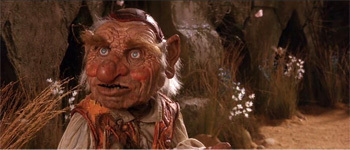
"When the Fraggles came, it was a massacre."
Sarah later meets a set of door guards who ask her a riddle. She figures it out, but when she asks if she's right, their response is "I don't know, I've never understood it," implying that the guards have played the game many times.

Just like we've never understood what's going on with these guys. Are they pooping out their partners?
All the little creatures who move parts of the maze around and play tricks on Sarah do their work with ease, again suggesting that it's something they're used to doing. The most damning evidence comes from the bridge guard, who says "Have no fear, this bridge has lasted for 1,000 years."

"At night, it's where I draw some blood and give my life away."
That means the labyrinth is at least a millennium old. Jareth's world has the same linear time that ours does -- otherwise, his 13-hour deadline would be meaningless. And we doubt that Jareth built the thing and then sat on it for a few centuries. The most logical assumption is that Jareth was kidnapping other kids and making other siblings go through the maze, and judging by Hoggle's demeanor, they didn't all get happy endings.
Sarah rescues Toby at the end of the movie, but Jareth doesn't die -- he's just disappointed that he couldn't get another baby for his horde, and that Sarah wouldn't respond to his disturbing professions of love. He's free to go back to torture-seducing teenage girls before adding their siblings to his goblin gang. It's nice that Sarah got a happy ending, but what about all the girls before her who either died in the labyrinth or went insane following the bizarre loss of their loved ones? Even with a conservative estimate -- say, Jareth gets bored and dusts off his labyrinth once a year to keep himself entertained on the off-week before the Super Bowl -- that's a hell of a lot of dead and disappeared kids.
Mike thinks Twitter is a vast communist conspiracy, but can only express his rage in 140-character outbursts. Tell him how stupid that is here.
For more things you may have missed in movies, check out 6 Horrifying Implications of Classic Christmas Movies and 5 Light-Hearted Movies With Dark Moral Implications.
Help Cracked retroactively ruin more childhoods. Click the Facebook 'share' button below.